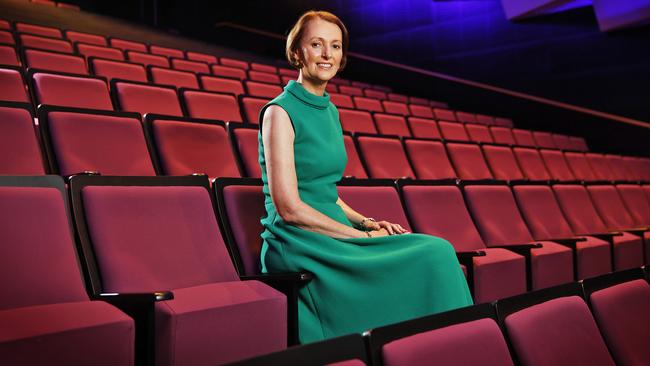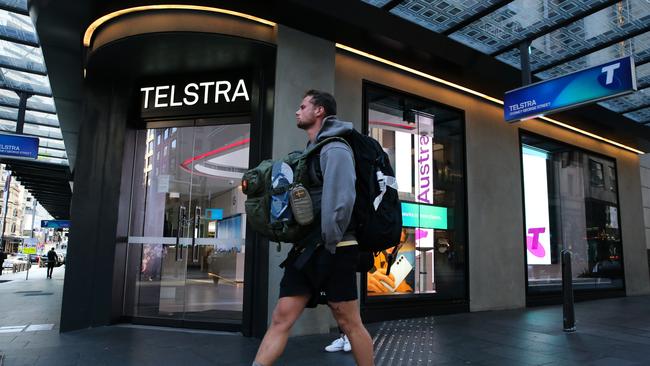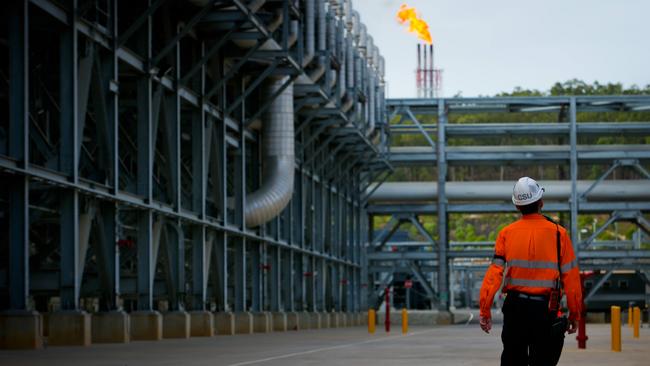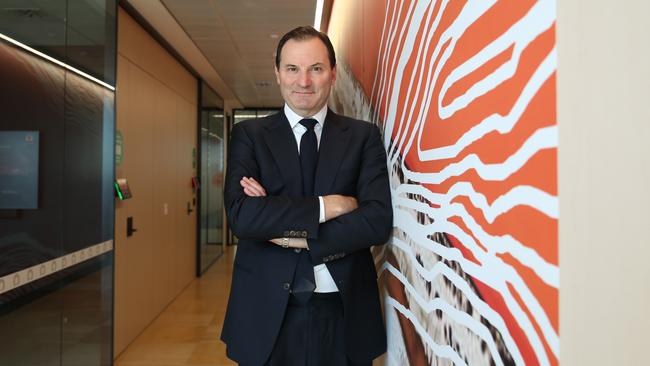Behind Vicki Brady’s plan for Telstra’s new era
The picture of Vicky Brady’s Telstra is starting to emerge as the new chief executive delivered her first set of numbers.

Business
Don't miss out on the headlines from Business. Followed categories will be added to My News.
The picture of Vicki Brady’s Telstra is starting to emerge as the new chief executive delivered her first set of numbers. For the past few years Brady has been Telstra’s chief financial officer and has used that experience to sharpen her message to investors.
After years of being internally focused through cost cutting and streamlining, Brady is building her leadership around three core areas: Delivering “quality” profit growth across its massive mobiles business, driving the underperforming NBN business harder, and getting Telstra back in the frame to win big business customers.
The promises aren’t about reinventing tomorrow’s Telstra, rather it is getting the basics right and betting growth will follow through from that.
That came about as Telstra boosted its first-half dividend to 8.5c a share and reported strength in its mobile business for the first time in years. Brady’s headline profit for the half was up 25.7 per cent to $934m and she stuck to a $7.8bn to $8bn underlying full year earnings guidance.
As a testament to last year’s smooth transition between former chief Andy Penn and Brady, there is full continuity of strategy and Brady was quick to recommit to Penn’s parting promise to deliver $500m in additional savings by 2025.

Brady’s cost-cutting pitch has additional difficulty given the headline number was devised well before inflation was pushing 8 per cent and wages pressures became acute. Both are expected to add to persistent costs for at least the next two years and Brady has to find a way around it.
Brady paid tribute to Penn’s own McKinsey-inspired $2.5bn cost-out strategy – dubbed T22 – as delivering the right platform for the times. Indeed many companies the size of Telstra are now grappling with cost bases and what was an old world telco is now in a unique position where it has the edge on efficiency.
There’s an acknowledgment the T22 program was as disruptive for customers as it was the telco so Brady says there is new urgency in getting people onto new technology and providing the best connections for data-hungry devices. Internally there is a target of using artificial intelligence to drive Telstra’s processing technology within the next two years.
“Despite our good progress on customer experience, there is still more we need to do. Our work to digitise, simplify and upgrade our legacy systems is transforming our customer service, but has been disruptive for our people and customers, so it is critical we finish the job as quickly as possible,” Brady says.
In December Telstra formed a joint venture with data analytics firm Quantium which will see AI options also become available to Telstra’s customers.

Interestingly Telstra, as expected, was a major beneficiary from the fallout from Optus’s massive cyber attack last year, adding tens of thousands of new customers across both retail and business. But the sales bump was short-lived with the customer switch now around normal competitive pressures, with some existing Telstra customers looking to drift away as price rises came through.
Indeed it was the addition of inflation-linked pricing in its mobile phone and NBN contracts that now gives Telstra shades of an infrastructure play and makes the telco more attractive in a high inflation market.
Brady isn’t backing away from pressure on the NBN with submissions closing this week around the networks new pricing proposals, particularly for the mid-tier 50Mbps and lower 20Mbps plans. Almost half of Telstra’s customers sit on those plans and price rises pushed through by the NBN will be immediately passed on to customers.
State of Origin
Takeover talks between Brookfield and Origin Energy are getting to the very pointy end but the market is pricing the $18.4bn deal at a one-in-four chance that it won’t be at the current price tag, if it gets away at all.
That means Origin is trading more on its own fundamentals of a coal-fired electricity and LNG exporter in the midst of massive shift to renewables and all the disruption and political turbulence that comes with it, rather than a company about to swap contracts under a mega-takeover.
Both sides were at pains to point out due diligence on Origin by Brookfield and private equity firm Mid Ocean Energy had been “substantially” completed, with no surprises and there was nothing more to add.
A drawn-out due diligence was always on the cards due to the complexities of dealing with a multi-member consortium and the prospect of splitting Origin into two businesses from almost day one added to complications.

The key is active negotiations were continuing, both sides insisted they were motivated and now focus had switched back to the board level. However, there is a real dynamic around political risk and Brookfield and its backers need to work through that.
In short, the Albanese government’s gas code of conduct has created long-term uncertainty around future gas prices that Origin’s LNG cash cow may receive, which remains a sticking point.
Still, the Origin board worked hard to secure a $9.00 a share indicative offer announced last November and they have little appetite to negotiate that away on what they see as manageable policy shifts in the energy market. Origin on Thursday closed down 3.2 per cent at $6.88.
For his part Origin chief executive Frank Calabria says the Brookfield process remains a matter for the board, which means he can focus on what he can control, which is planning his energy company for the green transition.
“We have to be disciplined … you have to think quite deliberately about how you don’t let the organisation be distracted (by the Brookfield offer),” he tells The Australian.
This includes planning for future moves, including moving ahead with a final investment decision on the new big battery at the Eraring coal-fired power plant that has been earmarked to close in 2025.
Despite the headline noise of the numbers, Calabria says the Origin machine is running well with LNG delivering strong cashflow, and that is helping to support lower energy output following weather-related disruptions.
“We are two businesses,” he says of Origin’s distinct LNG and domestic electricity operations. “But that’s always provided a reasonable hedge against what could also be going on in energy markets and provides us with diversification.”
Origin’s first half underlying profit, its preferred measure of earnings, fell to $44m from $268m. However, confidence in the looming June half, with price rises coming across more than 4 million customers, prompted Origin to boost the dividend to 16.5c per share from 12.5c previously.

In the energy market Origin is still playing catch up with the high costs from last winter’s disruptions and buying expensive oil and gas prices, but its cut-off for pushing through tariff price rises is in the middle of May. These price rises will ultimately be passed on to customers during the June half, but until then Origin’s earnings are carrying the difference.
For now Calabria and his team are working through the implications of the Albanese government’s pre-Christmas price caps on coal and gas, as well as the uncertainty the code of conduct presents. Origin as a buyer of coal is a beneficiary of cheaper coal, but as a gas producer the main focus is the implications of the gas mandatory code. Proposed wording of reasonable pricing under gas contracts remains up in the air. Calabria says necessary investment to developing new domestic gas fields won’t flow until there is certainty over how the policy will work.
Even so, almost all of Origin’s gas supplies for this year had been contracted prior to the cap coming into effect.
Despite the caps, Calabria says engagement with Canberra remains strong with all levels of federal departments now involved. But the pressure is in the tight time frames industry often faces when it comes to the government asking for feedback.
Meanwhile Calabria says reliability of the grid remains a major focus of the industry for coming months, with AGL’s ageing Liddell plant set to be turned off shortly. Last year there was perfect storm with wind and solar production falling off in the cooler months while gas demand was rising and offline capacity was crunched the market
The winter months can highlight just how interdependent gas and electricity are in Australia which can be a major pinch point, Calabria says.
johnstone@theaustralian.com.au
More Coverage
Originally published as Behind Vicki Brady’s plan for Telstra’s new era





